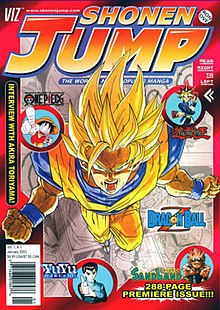Viz produces the Shonen Jump which is a manga anthology magazine. The genre of manga which contains titles such as Kuroko’s Basketball, Naruto, Yu-Gi-Oh, JoJo’s Bizarre Adventure, and One piece Adventure and also allures to young people. The world most popular manga is the Shonen Jump. After being officially remodeled SHONEN JUMP and abbreviated SJ, Shonen Jump was published by Viz media located in North America as a shonen manga anthology.
| Popular Genre of Manga | Advertising Associates of Shonen Jump |
| Kuroko’s Basketball | Diamond Distributors |
| Naruto | Cartoon Network |
| Yu-Gi-Oh | Suncoast |
| Joho’s Bizarre Adventure | Warner Bros. |

When did the Shonen Jump had its first debut?
It was in November 2002 that Shonen Jump debuted where the first issue had a January 2003 cover date. Shonen Jump is rewritten and re-edited for mostly English readers and the American people, including altering it from a weekly publication to a monthly one, based Shueisha ‘s popular Japanese magazine Weekly Shōnen Jump. It has in it enlisted chapters from four manga series, articles on Japanese culture and language, and also figurines, anime, manga, and video games. Shonen Jump succeed where other manga anthologies publicized in North America had failed because Viz launched a substantial marketing crusade to boost and promote it before the magazine was launch.
What’s the relationship between Viz, Diamond Distributors, Cartoon Network, and Suncoast?
To help fund the venture, an equity interest was purchased by Shueisha and, Diamond Distributors, Cartoon Network, and Suncoast was selected as the promotional papers in the magazine. Viz inaugurated new imprints for releasing media related to other shōnen works and the series presented in the magazine in conjunction with the magazine. This includes a label for the release of art books, an anime DVD imprint, a label for fan and data books, two new manga imprints, and a fiction line for releasing light novels. The first issue from the Viz Media required three printings to meet the needs of the consumer, with over 300,000 copies being sold, which was targeted at young male adults.
When did the Shonen Jump received the “Comic Product of the Year” award?
In December, 2002, the ICv2 awarded it with “Comic Product of the Year” award. After that, in 2008, the magazine went on to get a kick out of high sales with more than 215,000 monthly circulation. Rather than store sales, almost half of the circulation came directly from subscriptions. Shonen Jump’s fastened polybagged issues were now put into consideration just after the end of its physical global spread where it was highly yearned for by comic books collectors and fanatics.
When was the final issue of Shonen Jump published by the Viz Media?
In 2012, the final issue was published by the Shonen Jump, and Viz Media chose to be more dedicated to its weekly digital manga anthology. In January 2012, the Weekly Shonen Jump which was formerly known as the Weekly Shonen Jump Alpha was launched. Weekly Shonen Jump is an effort to offer English audience with readily availability, inexpensive based upon Shueisha’ s well known Japanese magazine Weekly Shōnen Jump. On the 10th of December, 2018, released the Shonen Jump electronic vault and posted its Weekly Shonen Jump’s ultimate digital issue, which offers just only small amount of free electronic chapters. That’s not all, there’s also a membership service to help audiences get back into the catalogue at the back of its Shonen Jump titles. In January 2018, Viz released a worldwide variant of Shonen Jump+ and Shueisha named it Manga Plus.
Is Attack on Titan Shonen Jump?
If you’re talking about one of the most popular manga and anime series, Hajime Isayama’s Attack on Titan is one of them. It is Shonen Jump and had grow even bigger in the last few year with Warner Bros having produced a new live-action movie of it.
What is the Brief History of Shonen Jump?
Shonen Jump was announced after Shueisha and Viz Communications, popularly known as Viz Media, created partnership, to began creation in June 2002. However, an English twist on the extremely popular manga anthology of Shueisha called Weekly Shonen Jump. As advertising associates, top companies like Diamond Distributors, Cartoon Network, along with Suncoast was signed. Viz observed it wouldn’t be a “word for word” text though dependent on Weekly Shōnen Jump. Viz, instead, selected series of its magazine that seem suitable for all of its Americans audiences. Instead of weekly publications, Viz’s edition had also been set to be monthly, so as to deliver something that will fit the American comic distribution program.
One of the prominent editors of Viz’s manga, Jason Thompson z who had done well for series like Dragon Ball was elected to be the very first editor-in-chief of the magazine. Primarily, Viz’s thought was to share magazines that are well suited for all age groups. Moreover, the choice was created to draw the magazine as being for people thirteen years of age and more mature to permit greater independence on content material. Interestingly, several titles had been edited for content even with greater interest and attention getting centered on Viz’s manga as it started to be obtainable in mainstream outlets. “Most of the artists whose works will show up in the very first issue, who worried about too much alterations” had created a lot of challenges for us, said Mr. Thompson.
In North America, at first, the manga anthologies were not really successful, so the Viz decided to circulate one million of Shonen Jump within its very first 36 months. Therefore, Viz launched the magazine with a multimillion dollar marketing budget to help with this main objective. Instead of using simply pop culture retailers, they sent out the name via mass mass marker retailers and advertised as well, to make sure the magazine provided series currently widely used together with the North American market as a result of the airing of theirs on Cartoon Network.
Viz had given retailers the opportunity to return the initial two issues unlike with many other magazine launches. This is a very good move for merchants to know how effective the sale of the magazine would be in areas where the manga anthologies was not known. Viz also provide merchants with some samples that are free, distributed 100,000 free samples at Comic Con. That’s not all, Viz also distributed an additional 100,000, which were made available to the partner Suncoast of its. Cartoon Network started sample chapters content to it and also started supplying streaming videos to its Adult Swim website. The Adult Swim website also has distinguished url links to Shonen Jump’s official website.
On 26th of November, 2002, the very first issue was released, having its option date on January 2003. It then premiered with five series. The development of Shojo Beat was announced by Viz in February, 2005, which was more of another version of Shonen Jump published to suit female audiences and fans. In June, 2005, the launching of a sister publication of Shonen Jump took place with a July 2005 date cover; it was however stopped when the issue in July 2009 was introduced but it ran for 47 issues. For equally magazines, Viz named Marc Weidenbaum as the Editor-in-Chief in 2006. It was on the 13th of February 2009 that the company announced that Weidanbaum had left the position of the magazine’s editor.
In a year, almost ten issues were published as of the June 2011 issue. It was at the Transcontintental Printing RBW Graphics, Owen Sound that the magazines were printed in Ontario, Canada. Viz had early announced that a weekly digital version of the magazine, which is referred to as the Weekly Shonen Jump Alpha, would be made available to audiences and fanatics as from 30th of January, 2012. After Weekly Shonen Jump Alpha was released, Viz then released the finale of the Shonen Jump in match of that same year.
What’s the Audience and Circulation?
The Shonen Jump original issue was among the best comic titles in 2002 and sold more than 300,000 copies which was far exceeding Viz’s expected 100,000 copies. The very first printing of 250,000 copies was sold out prior to the issue was launched, and to completely meet up with the needs, 2 extra printings have been made. The magazine had an average month-to-month blood circulation of 190,000, but by the first anniversary of its, it quickly grew to 305,000 subsequent to the original launch. The August 2003 issue, was the best problem with 540,000 copies sold, having including a demo edition of an upcoming Yu-Gi-Oh! PC game. The magazine had a blood circulation of 215,000, with subscriptions constituting fifty-four % of the copies distributed as of 2008.
Even if the Viz Media focused on “tween & teen male consumers”, the magazine likes a somewhat high amount of adult and female readers also, comprising thirty-six % along with thirty-seven % of the readership of its, respectively. Fifteen years is the median age of The Shonen Jump audiences, and more than 50 % of the market is between the ages of twelve as well as seventeen. Recognized measurements by Simmons notes that among the small era audience the female readership is somewhat reduced and also the median age is twelve.
What exactly are the Imprints?
Viz Media has produced a couple of brand new imprints in its many divisions in conjunction with all the Shonen Jump anthology. “Shonen Jump” may be the main manga imprint for releasing the tankōbon volumes of the series which have been seen in various other very similar shōnen titles and magazines which were enlisted in some other Jump publications in Japan. “Shonen Jump Advanced” was the next manga imprint which was released in April 2005 with increased “mature themes to focus on older teenage as well as young adult audience.” Viz expanded the “Shonen Jump” imprint in their home video releases in October 2005. “Shonen Jump Home Video” provides initial footage animations as well as anime series taken from manga series developing in Shonen Jump.
The “SJ Fiction” imprint was announced in 2006, with the Viz Fiction line. The imprint is utilized for mild novel releases regarding manga series developing in Shonen Jump. “SJ Profiles” prints fan guides, information guides, along with any other similar works for the Shonen Jump sequence, while art publications are released under the “Art of SJ” imprint.
Final Words
Again, the world most popular manga is the Shonen Jump. After being officially remodeled SHONEN JUMP and abbreviated SJ, Shonen Jump was published by Viz media located in North America as a shonen manga anthology. We have come to the final session of this informative article. We hope you were able to find good resources in your quest to know what Shonen Jump means. Please do not hesitate to contact us if you have any questions or comments on this topic.

Arthur was a dedicated feature writer for a local newspaper in Nashville, TN. He later resigned and then started researching various newspapers and magazines from all over the world. He reviewed all the best magazines & tabloids and started reviewing them one by one here in Posora. Find him on Twitter & FB.